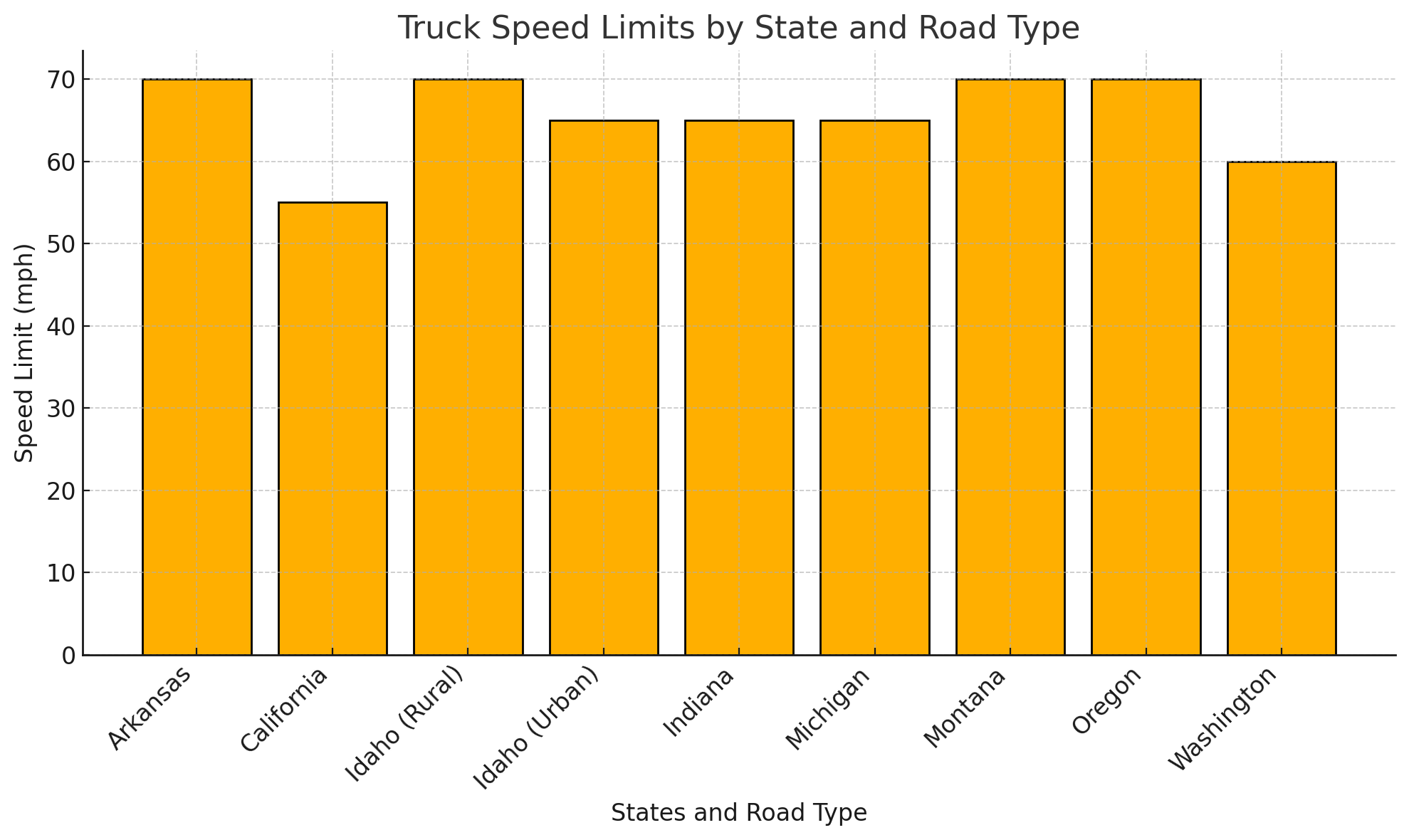Key Takeaways
- The highest speed limit in the US is 85 mph on a Texas toll road, reflecting its unique road conditions.
- Speed limits differ across states, ranging from 55 mph on highways to 25-35 mph in residential zones.
- They are designed to prevent accidents, improve safety, and maintain efficient traffic movement.
- Tools like Matrack’s GPS trackers help enforce speed compliance and reduce risky driving behaviours.
What is the highest speed limit in the us?
The highest speed limit in the United States is 85 mph (137 km/h), found on a toll road in Texas. Speed limits have been around in America since 1901, starting with Connecticut’s law that allowed only 12 mph in cities and 15 mph on country roads.
Speed limits have changed over time to keep up with new needs and better cars. In the 1970s, a national limit of 55 mph helped save fuel, but in the 1990s, states got to set their own limits again, with many raising them to 70 mph or more.
Today, each state has its own speed limits based on local rules and road safety. While higher speeds save time, following speed limits is important to stay safe and avoid fines.
What is the Purpose of Setting a Speed Limit
Involving in a traffic accident while driving on roads is the most unfortunate thing that can happen to you. Numerous studies indicate that speeding is one of the primary causes of fatal accidents.
The authorities define speed limits by considering the suitability for the respective road, region, and traffic circumstances to minimize the risks of collisions and ensure everyone’s safety.
US Speed Limits in Different States
The maximum speed restriction for drivers varies from state to state. You will find that the limitation on the fastest speed is higher in rural roadways with lower population and less traffic.
The Highway Loss Data Institute (HLDI), in collaboration with the Insurance Institute for Highway Safety (IIHS), prepared the list below to provide a clear view of the differences in speed restrictions on US highways.
| List of US Speed Limits in Different States | ||||
| State | Rural Roads (mph) | Urban Roads (mph) | Other limited access roads (mph) | Other roads (mph) |
| Alabama | 70 | 65 | 65 | 65 |
| Alaska | 65 | 55 | 65 | 55 |
| Arizona | 75 | 65 | 65 | 65 |
| Arkansas | 75 | 65 | 75 | 65 |
| California | 70 | 65 | 70 | 65 |
| Colorado | 75 | 65 | 65 | 65 |
| Connecticut | 65 | 55 | 65 | 55 |
| Delaware | 65 | 55 | 65 | 55 |
| Florida | 70 | 65 | 70 | 65 |
| Georgia | 70 | 70 | 65 | 65 |
| Hawaii | 60 | 60 | 55 | 45 |
| Illinois | 70 | 55 | 65 | 55 |
| Indiana | 70 | 55 | 60 | 55 |
| Iowa | 70 | 55 | 70 | 65 |
| Kansas | 75 | 75 | 75 | 65 |
| Kentucky | 65 | 65 | 65 | 55 |
| Louisiana | 75 | 70 | 70 | 65 |
| Maine | 75 | 75 | 75 | 60 |
| Maryland | 70 | 70 | 70 | 55 |
| Massachusetts | 65 | 65 | 65 | 55 |
| Michigan | 70 (75 on specific roads) | 70 | 70 | 55 |
| Minnesota | 70 | 65 | 65 | 60 |
| Mississippi | 70 | 70 | 70 | 65 |
| Missouri | 70 | 60 | 70 | 65 |
| Montana | 80 | 65 | 70 | 70 |
| Nebraska | 75 | 70 | 70 | 65 |
| Nevada | 80 | 65 | 70 | 70 |
| New Hampshire | 65 (70 on specific roads) | 65 | 55 | 55 |
| New Jersey | 65 | 55 | 65 | 55 |
| New Mexico | 75 | 75 | 65 | 55 |
| New York | 65 | 65 | 65 | 55 |
| North Carolina | 70 | 70 | 70 | 55 |
| North Dakota | 75 | 75 | 70 | 65 |
| Ohio | 70 | 65 | 70 | 55 |
| Oklahoma | 75 (80 on specific roads) | 70 | 70 | 70 |
| Oregon | 65 (70 on specific roads) | 55 | 65 | 65 |
| Pennsylvania | 70 | 70 | 70 | 55 |
| Rhode Island | 65 | 55 | 55 | 55 |
| South Carolina | 70 | 70 | 60 | 55 |
| South Dakota | 80 | 80 | 70 | 70 |
| Tennessee | 70 | 70 | 70 | 65 |
| Texas | 75 (80 on specific roads) | 75 | 75 | 75 |
| Utah | 75 (80 on specific roads) | 65 | 75 | 65 |
| Vermont | 65 | 55 | 50 | 50 |
| Virginia | 70 | 70 | 65 | 55 |
| Washington | 70 (75 on specific roads) | 60 | 60 | 60 |
| West Virginia | 70 | 55 | 65 | 55 |
| Wisconsin | 70 | 70 | 70 | 55 |
| Wyoming | 75 (80 on specific roads) | 75 (80 on specific roads) | 70 | 70 |
Note: Every state in the US sets speed limits, which shows how important it is to drive safely.
US Speed Limits in Residential Areas
When driving through a residential area, you must exercise extra caution with your speed due to the presence of pedestrians, which increases the risk of fatalities at higher speeds.
In these situations, especially with large vehicles, you should significantly reduce your speed. This is why authorities typically set the maximum speed limit at 25 mph in residential areas. Rural roads or highly curved roads may restrict you to 10 mph.
State-Wise Residential Areas Speed Limits
The speed restriction also applies in residential zones and varies from state to state. The chart below gives you an overview of the state-wise speed barriers in miles per hour.
| List of State-Wise Residential Areas Speed Limits | ||||
| Alabama, 30 | Idaho, 35 | Massachusetts, 30 | New Mexico, 35 | South Dakota, 25 |
| Alaska, 25 | Illinois, 30 | Michigan, 25 | Delaware, 25 | |
| Arizona, 25 | Indiana, 30 | Minnesota, 25-30 | North Carolina, 35 | Texas, 30 |
| Arkansas, 30 | Iowa, 20-25 | Montana, 25 | North Dakota, 25 | Utah, 25 |
| California, 25 | Kansas, 30 | Nebraska, 25 | Ohio, 25 | Virginia, 25 |
| Colorado, 30 | Kentucky, 35 | Montana, 25 | Pennsylvania, 35 | Virginia, 25 |
| Georgia, 30 | Maryland, 30 | New Jersey, 25-35 | South Carolina, 30 | Wisconsin, 25 |
In some regions, the residential speed limit under state law is the same as the indicated state speed limit unless specific instructions are displayed. These states include Mississippi (65 mph), Missouri (60 mph), Oklahoma (65 mph), Vermont (50 mph), Tennessee (65 mph), Louisiana (55 mph), and Nevada (75 mph).
Limiting Speeds for Truck Movements
Trucks are heavy commercial vehicles that primarily run on highways while carrying various loads. If you are driving trucks across state borders, you should know the maximum speed permissible in a specific state. Here is a summary indicating how fast you can move your truck without violating the law.

- Arkansas: Restricts truck speeds on rural interstates to 70 mph.
- California: All interstates and roads have a 55 mph speed restriction for trucks.
- Idaho: Trucks can only travel 70 mph on rural interstates and 65 mph on urban areas.
- Indiana: The speed restriction for rural interstate trucks is 65 mph.
- Michigan: The maximum truck speed in rural areas is 65 mph.
- Montana: The rural interstate truck speed limit is 70 mph.
- Oregon: Trucking is allowed at a top speed of 70 mph.
- Washington: Rural interstates require a maximum speed of 60 mph.
Trucking speed can be restricted depending on the cargo you carry. While transporting hazardous materials in your semi-truck, you need to maintain a speed of 55 mph when you are in the state of Alabama.
Again, there are localized speed limitations. In California, you can drive up to 55 mph on two-lane highways, on multi-lane tracks, it is typically 65 mph.
Consequences for Crossing Speed Limits
Driving at high speed on open highways may be exciting. Still, it is crucial to note that overspeeding can be risky and lead to significant accidents. Therefore, to ensure the safety of drivers and other road users, a control on speed is necessary, which also helps you remain compliant with legal regulations.
Many US states, including Florida, deal with speed restriction violations severely. Over-speeding in Florida has severe consequences, including fines and license point accumulation.
Florida traffic guards will charge you with a fine of between $193 and $226 for exceeding the restricted speed by 10 miles per hour, whereas driving thirty miles per hour over the speed limit requires you to settle the matter through court proceedings.
Georgia decides penalties for speeding violations based on your excess speed above the specified. If you exceed the speed limit by 10–14 miles per hour, authorities could fine you $100 for your first offense.
Speed Limitations at Night Driving
The figures we discussed so far are mostly the general speed limit applicable at any time of the day. However, in certain states, there are special instructions to maintain limits on the speed at which vehicles drive at night.
- In Montana, night driving limits are 65 mph on restricted access routes.
- Colorado and Florida adjust their speed limits at night as wildlife will likely move on specific routes.
- Washington also requires reducing the speed of trucks because there are a lot of deer roaming on certain highways at night.
Frequently Asked Questions
Which US state has the highest speed limit?
Texas has the highest speed limit in the United States at 85 mph. This limit is on a specific toll road between Austin and San Antonio.
What is the speed limit on state highways?
State highway speed limits usually range from 55 to 75 mph. The exact limit depends on the state’s laws and the type of highway.
How fast can drivers drive in the US?
The fastest legal speed limit in the US is 85 mph, found on a toll road in Texas. This is the highest speed allowed by law on American roads.
What is the maximum speed limit on rural expressways in North Carolina?
The maximum speed limit on rural expressways in North Carolina is 70 mph. This applies to most expressways outside urban areas.
What speed limit is 75?
A 75 mph speed limit is common on rural interstates and highways. States like Texas, Utah, and Wyoming often have this limit on open roads.
What is the minimum speed limit in the US?
Minimum speed limits in the US are generally 30 to 40 mph on highways. These ensure that traffic flows smoothly and safely.
Conclusion
Speed limits in the U.S. are designed to keep roads safe, efficient, and environmentally friendly. Following these limits helps drivers stay safe, follow local rules, and adapt to different road conditions.
To meet modern transportation needs, it’s important to follow sensible speed limits and stay accountable. A balanced approach keeps everyone safe and ensures smoother travel for all.
Matrack’s technology helps fleet operators manage speed and prevent unsafe driving. GPS Fleet tracker sends instant alerts for overspeeding, and fleet dash cam monitors risky driving, helping fleet managers take quick action to ensure safer driving and better road safety.



